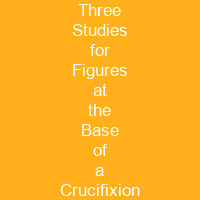Three Studies for Figures at the Base of a Crucifixion: A Masterpiece by Francis Bacon
Is there any painting that encapsulates the raw emotion and turmoil of human existence more vividly than Three Studies for Figures at the Base of a Crucifixion? This 1944 triptych, painted by the renowned British artist Francis Bacon, is not just an artwork; it’s a profound exploration of pain, suffering, and the human condition. The canvases depict three writhing anthropomorphic creatures set against a flat burnt orange background, based on Aeschylus’s Oresteia. But why did Bacon choose this particular theme? And what makes these figures so hauntingly real?
The Birth of a Masterpiece
Bacon began working on images based on the Crucifixion in 1933 but struggled with his early works, which lacked substance and urgency. After returning to the topic eleven years later, he retained stylistic elements from earlier works and incorporated new devices such as radiating lines from a central figure. The painting was executed under difficult conditions, including hangovers and excessive drinking. Bacon refused to include pre-1944 images in his canon, and most early art critics agreed that this triptych marked the beginning of his mature period.
Metaphors of Suffering
The figures are portrayed with layers of white and grey paint, each having distinct characteristics: the left figure bears a mourner-like appearance, the central figure bares its teeth as if snarling, and the right figure’s mouth is stretched open in a scream or yawn. These metaphors of suffering and pain are not just visual; they resonate deeply within the viewer’s soul.
Revisions and Inspiration
Inspection under infrared reveals that the panels were heavily reworked during revisions. The legs of the central figure are surrounded by magenta horseshoe shapes that were initially drafted as flowers. Bacon mentioned using these figures at the base of a large Crucifixion, but it’s unclear if they were originally conceived as a triptych or individual works. The Furies have replaced Christ and the two thieves in the panels, with their forms borrowed from Picasso’s biomorphs. The Crucifixion itself is absent, and there is no evidence of its presence in the paintings.
The Agonized Spirit
Bacon’s treatments of the mouth were inspired by Aeschylus’ phrase ‘the reek of human blood smiles out at me,’ which haunted him and visualized the sentiment in his paintings. The triptych also draws from Sergei Eisenstein’s Odessa Steps massacre sequence, with the central figure’s mouth inspired by a nurse’s scream. In 1984, Melvyn Bragg confronted Francis Bacon about his work, noting that earlier he had been preoccupied with the physicality of the human mouth. Bacon attributed his failure to capture this aspect to his inability to convey color and interior details.
A Controversial Masterpiece
The public and critics were unnerved by the sight of Three Studies, describing it as unrelievedly awful and shocking. The artwork caused a sensation, turning Bacon into the most controversial painter in the country overnight. Raymond Mortimer wrote that Bacon’s Three Studies is ‘symbols of outrage’ rather than works of art, but critic Jonathan Meades disagreed, stating that the painting achieves power and impact despite being a polished work.
Enduring Impact
Irish author Colm Tóibín noted the triptych’s enduring impact in 2006, while Matthew Kieran described its visceral effect as jolting sensations of fright, horror, isolation, and angst. Bacon created a second version of the triptych in 1988, which was more refined but lacked the rawness of the original. Critics had mixed opinions on the revised work, with some finding it slicker but less powerful than the first version.
Three Studies for Figures at the Base of a Crucifixion is not just a painting; it’s a profound exploration of human suffering and emotion. It challenges us to confront our own inner turmoil and the rawness of existence. As Bacon once said, ‘Art is the lie that enables us to realize the truth.’ In this triptych, he has painted a truth that haunts us long after we have left the gallery.

You want to know more about Three Studies for Figures at the Base of a Crucifixion?
This page is based on the article Three Studies for Figures at the Base of a Crucifixion published in Wikipedia (retrieved on November 29, 2024) and was automatically summarized using artificial intelligence.







